| Author |
Message |
|
Brian Nelson
Location: Houghton, MI Joined: 17 Mar 2012
Posts: 43
|
 Posted: Mon 22 Sep, 2014 7:16 pm Post subject: Warbow Arrow Project Posted: Mon 22 Sep, 2014 7:16 pm Post subject: Warbow Arrow Project |
 |
|
Hey guys! I need to make quite a few weapons and armour for a medieval sound library I'm helping produce, and I thought I would share my first attempt at making "warbow" arrows for my 110 pound English longbow. I've made many arrows in the past for my English longbow, but I've never "properly" done them, with tapered shafts and horn inserts in the nocks. Hopefully this may help you if you are thinking of making some but don't know where to get started. This is an example of a an attempt at a process and pricing to making 1/4 pound "warbow" arrows. First I'll talk about the ordering and pricing.
SHAFTS
I ordered 150 poplar dowels of 1/2" diameter from Madison. "Dowels!" you are probably cursing in outrage. I know, I used to think the same way. But if you follow just a few basic quality control guidelines, you'll be just fine, and will never pay for shafts from a maker again. By 150 dowels cost me $120, shipped. Of these, about 20 were perfectly straight, 30 were very straight, 30 were decently straight, and about 70 shafts were unusable, either very warped or with pinknots or machining errors or excessive grain runout or such. So I basically paid $120 for 20 "premium," 30 "hunter," and 30 "seconds" quality shafts. For now I will pretend I don't want to do any straightening and say that I paid $120 for 50 good-very good arrow shafts. That's $2.40/shaft, a very good price.
BODKINS
I ordered one dozen heavy war bodkins from Hector Cole. They came out to about $16.25/bodkin. Now we're looking at $18.65/arrow.
HORN INSERT
I buy scales of horn that are used to make knives. I can get about forty horn slivers for nocks out of a slab that costs $8. I just picked it off ebay. That's $0.20/sliver and now we're at $18.85 for the whole arrow.
FLETCHES
I bought 200 feathers for $110. That comes out to $0.55/feather or $1.65 per fletched arrow. So, the grand total to make one of these heavy war arrows was about $20.40 for the entire arrow. (I am neglecting the cost of stain, glue, and binding as they cost so little per arrow, pennies or less.)
To put this in perspective, most places that make/sell proper warbow arrows charge around $40/arrow, and that's without one of these very expensive bodkins! With an arrow made the way this is, you're realistically looking at $50-60 each, over two and a half times what it costs to make them yourself!
Now that I've maybe convinced you that it's worth your money, I'll show you my process. It is not the best, and I still need work and practice, but I can make one of these arrows in around 1-1.5 hours total.
First, I sort out my shafts as mentioned previously, and end up keeping the best fifty that don't need any work or straightening as my first batch for arrows. I spend my time on this as I don't want any shafts with defects that could cause a failure during loosing. I would like to mention that I've made about 100 arrows from poplar dowels and have never had one break during loosing, and have only ever broken two shafts in all the targets and rocks and trees I've struck with them.

I then selected my heaviest shaft.

And my heaviest bodkin from Mr. Cole.
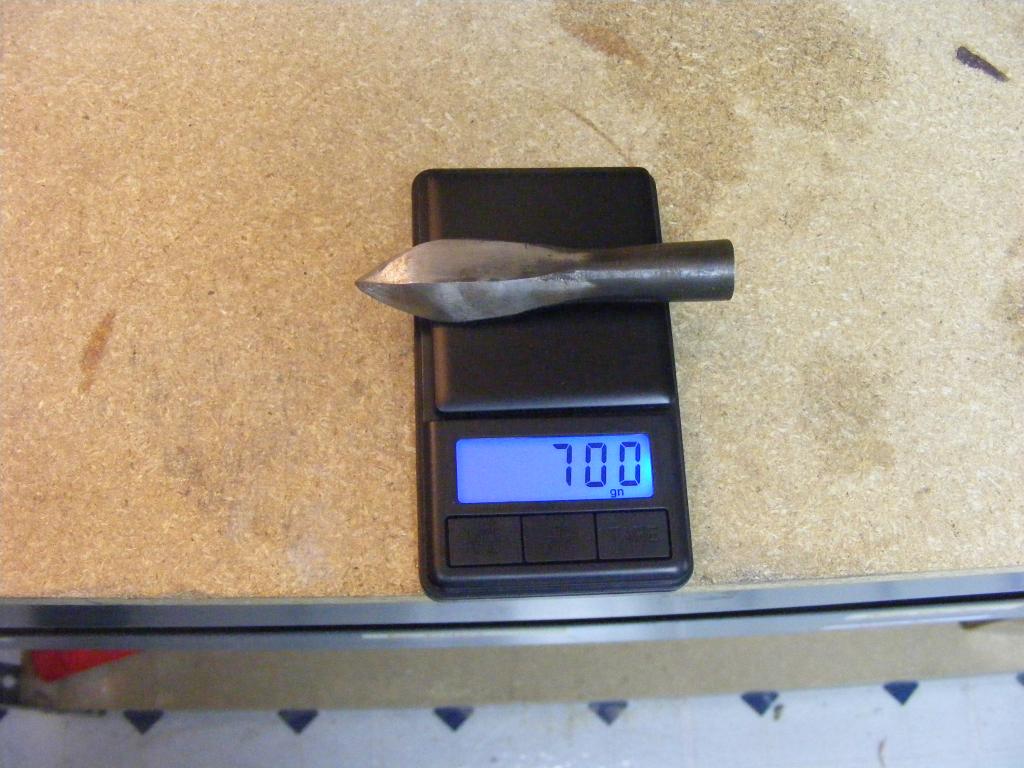
I then did some rough calculations. My shaft is 1182 grains for 36" at consistent 1/2" diameter. Using a length of 32", my cut to length shaft would weigh 1050 grains. However, I'll be tapering it from 1/2" at the point to 3/8" at the nock. Using the formula for a truncated cone, I find that the shaft after cutting and tapering should weigh approximately 850 grains. Because my point is 700 grains, and fletching and staining usually adds around 100-150 grains, I should come up with around 1650-1700 grains weight, not quite the target weight of 1750 grains. Oh well.
Now I cut the slot for the horn. I make this 2" deep and about 2mm wide. I two hacksaw blades taped together for this.
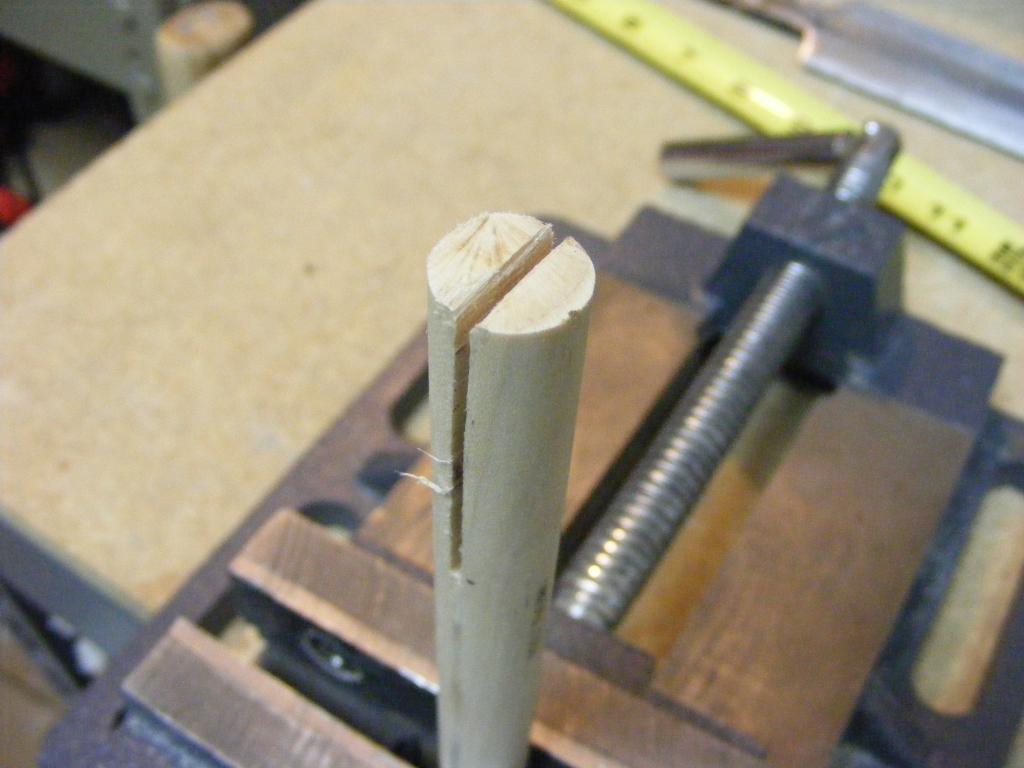
Now I make some horn slivers. I use a bandsaw and a custom wooden spacer I made which allows me to shave off perfectly 2mm thick slices from the horn slab. After testing the fit to be safe, I coat it in glue on both sides.

I then gently slide the horn sliver into the cut. After it's in there nice and snugly, I use a single clamp to hold it all together.
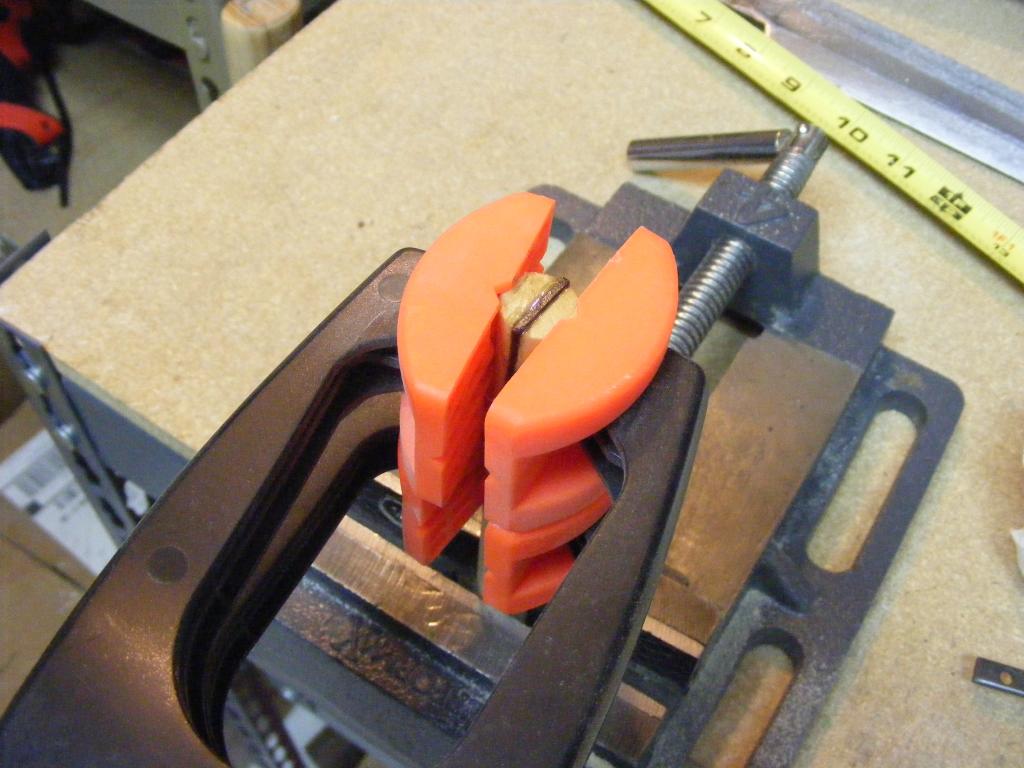
After drying (about one hour) I use a large file to shave off the protruding horn until the insert is a little flush. This is not the finished look, but this is necessary to allow the next step to be effective.

Now, I have to taper the shaft. I use a jig I made myself, consisting of two steel L-bars clamped to a board. One bar has a cloth-backed strip of sandpaper facing the interior of the channel. The channel is 1/2" wide at the start and tapers to 3/8" wide at 32" away from the opening.
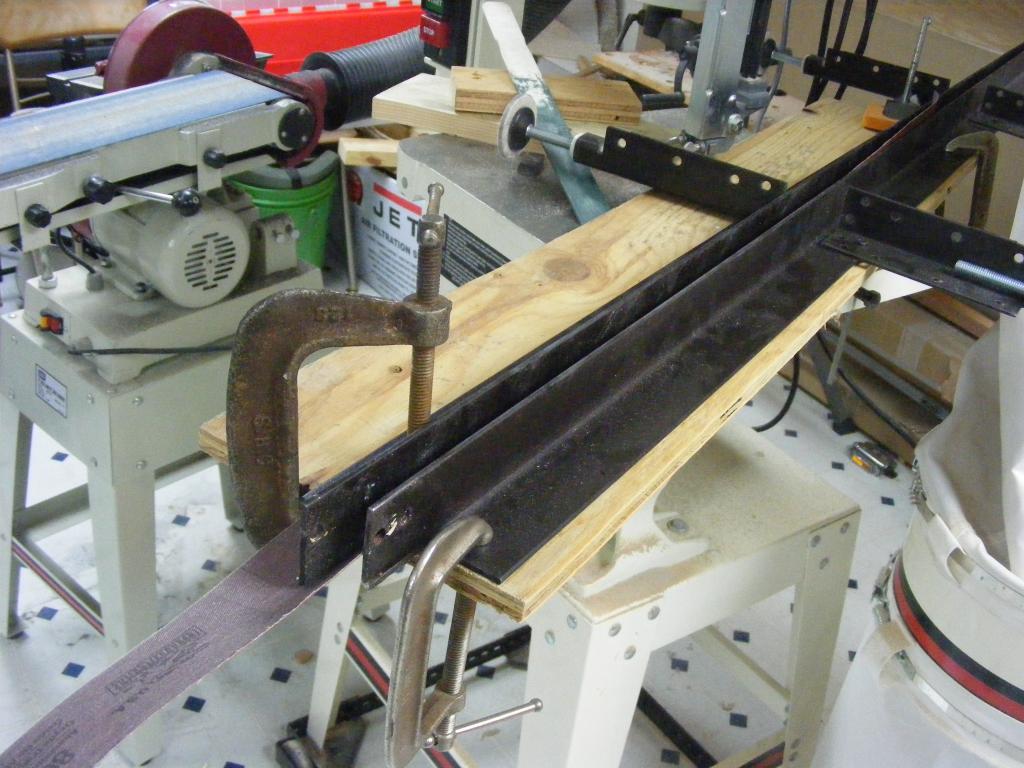
Now I wrap masking tape around the end of the shaft away from the horn to give it some grip. I then put the shaft tape-end into a drill chuck and snug it down. To taper, I just turn on the drill, and slowly and carefully run the shaft nock-first into the tapering jig.
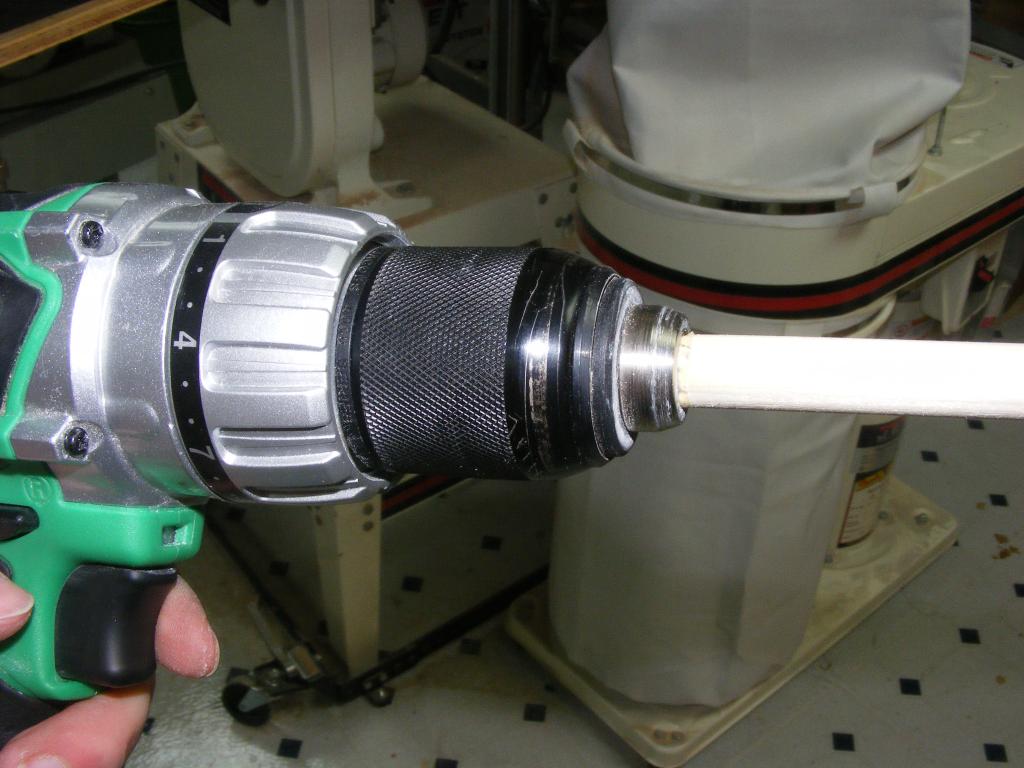
Now I cut the nock with three hacksaw blades taped together and use a small round file to make the nock smooth.
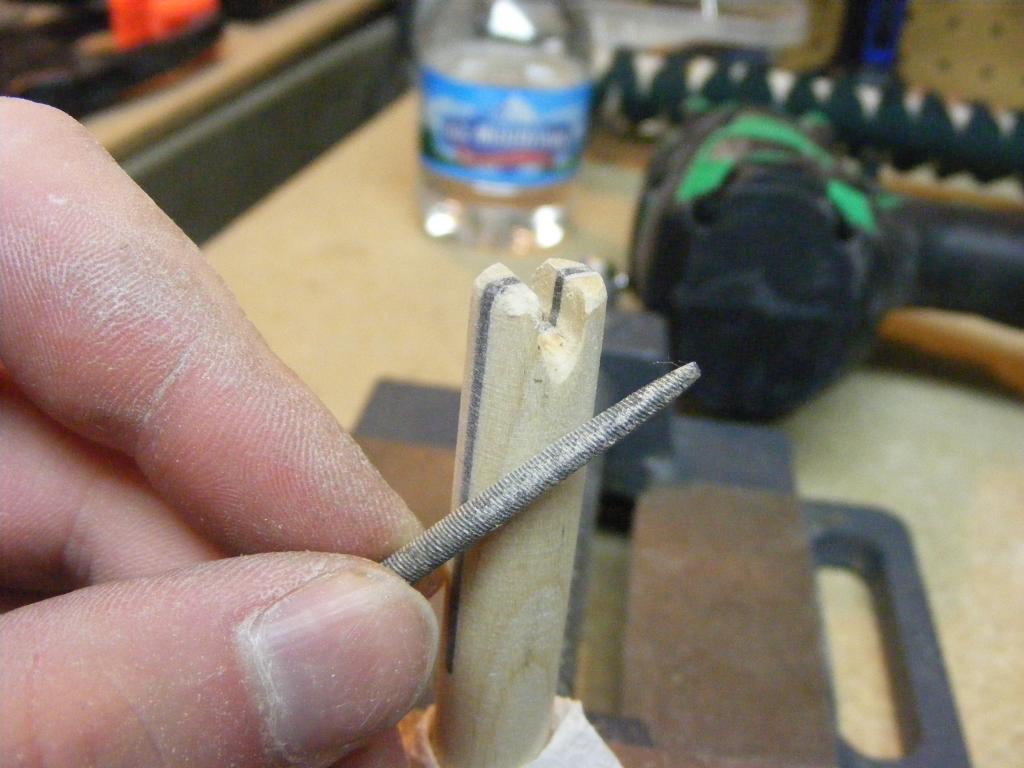
Now I cut the arrow to 32.5" and use the last inch for the point tenon. I cut a ring with a knife and then strip wood away from it to form a shoulder and tenon.

After that's done, and I do some test fitting and minor adjustments, I glue on the bodkin.
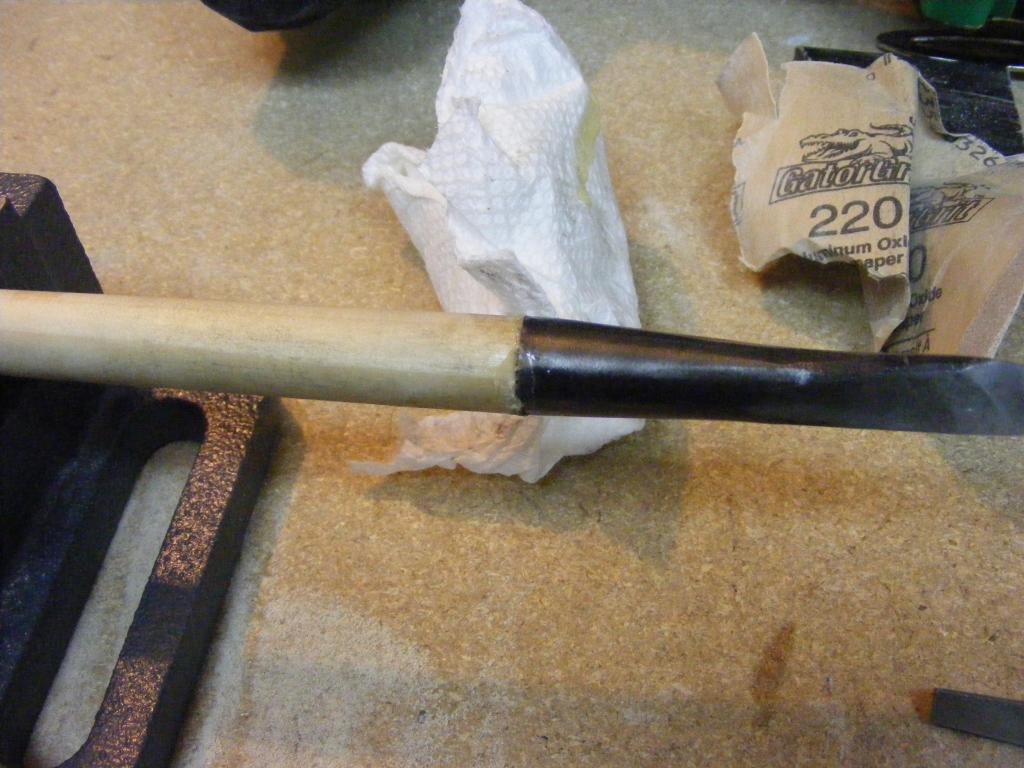
I now take 220 grit paper and give the whole shaft a smoothening job. I apply about 5 coats of danish oil and the shaft is complete.
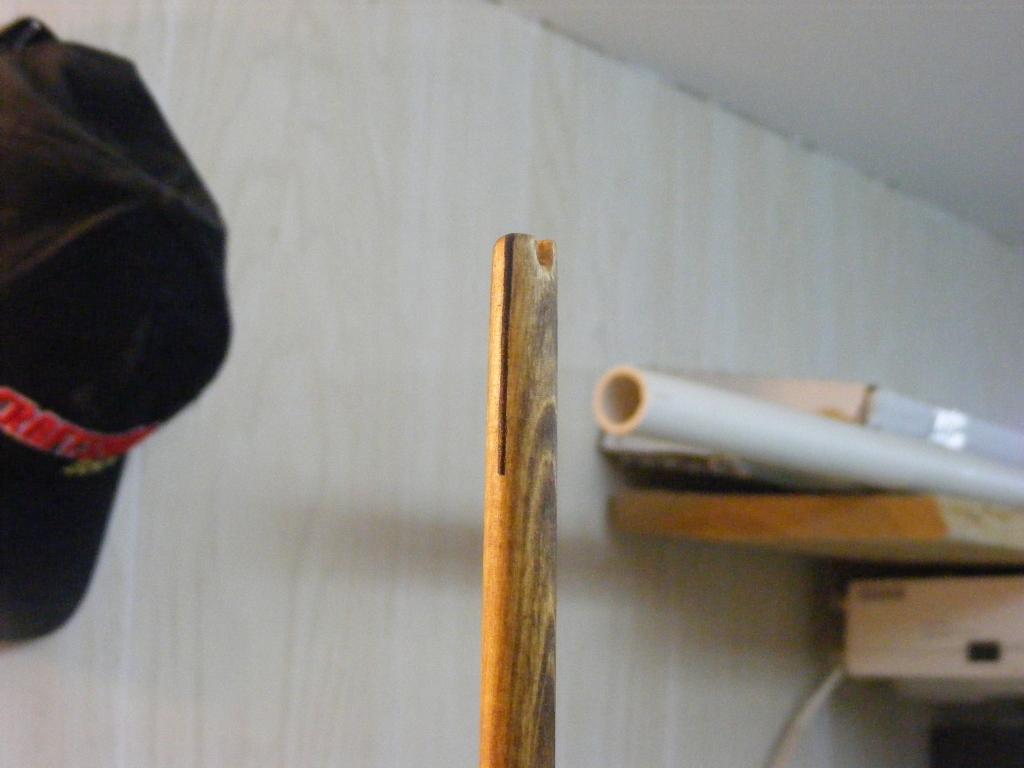
The only thing left to do is fletch the shaft. I cut my feathers to 7.5" x 3/4" and used red binding at about four turns to the inch. At the end, it came out like this.
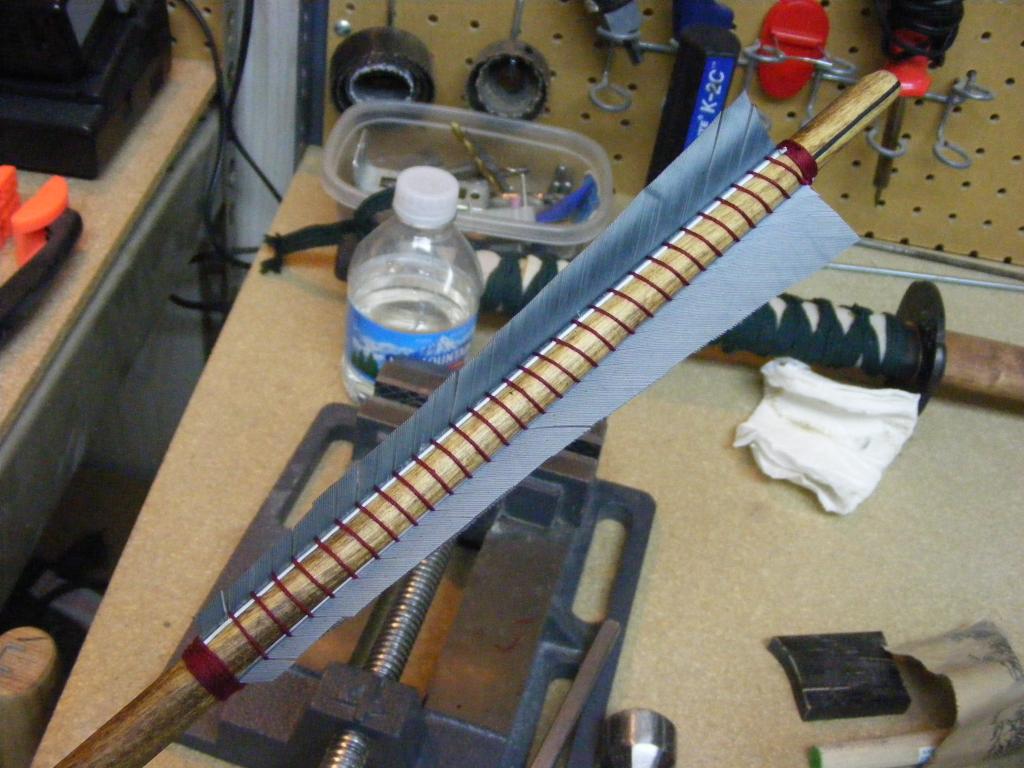
All told, the cost was about $20 and took about an hour and a half. Considering I saved about $30, I made a decent wage on this, and in batches I am able to do about one hour for an arrow. Also, I have some imitation machined Tudor bodkins from Richard Head that were only $3 each, would would put the cost of these arrows at under $10 each. I encourage anyone that is thinking of trying to make warbow arrows to go for it! It's not too hard with practice, just be careful with your dowel selection (or pay about $2 more per shaft to buy from an archery supplier) and you won't have any problems.
Total weight?

Not bad on the rough estimate! Unfortunately I couldn't quite get the 1750 grains I was going for. I think this is a problem with using poplar. The shafts just don't have the weight. I think if you really want the 1/4 pound shafts you need to use ash or birch. Poplar is too light. But it works wonderfully with 300 grain or so bodkins, the arrows come out to around 900-1100 grains which is a very nice target arrow weight for 100 pound and heavier bows. Hopefully this was all somewhat helpful!
Cheers!
Brian
|
|
   |
 |
|
Will S
Location: Bournemouth, UK Joined: 25 Nov 2013
Posts: 164
|
 Posted: Tue 23 Sep, 2014 2:38 am Post subject: Posted: Tue 23 Sep, 2014 2:38 am Post subject: |
 |
|
Very very nice, especially for a first try!! With some practice the whipping will get more even, and if you use a thinner red silk those will look fantastic. Did you varnish over the whipping at all? I find that without a few coats of something tough the whipping breaks and comes apart very easily after a few shots.
Hope you don't mind me offering some points I've picked up recently while making my own? (your arrows are superb, I'm just being nitpicky because it took me ages to discover this stuff for myself!)
You're right about the poplar not being suitable for 1/4lb arrows - personally I've used birch to hit the target weight, but oak works well also. One way of making sure you hit the 1/4lb weight is to make up a heavy shaft first, fully fletched, then work out exactly what weight the head needs to be and get those made up afterwards. Nothing more frustrating than buying all the bits only to find that you can't quite hit that target weight!
If you're struggling to make the weight even with a dense wood, then you can try torpedoing the shaft rather than bobtailing. A pure bobtail is tapered from the head to the nock, and the weight drops quite quickly this way. A better option for heavy arrows is to "torpedo" them - taper the last third only, so most of the arrow shaft is 1/2", and only the nock end tapers to 3/8". It also gives a slightly better balance when using a heavy plate cutter.
Hector's heads are fine, but incredibly expensive for arrows that ultimately end up getting lost, broken and so on. I've always thought of his heads as display pieces, as they're polished and immaculate etc. There are quite a few good arrowsmiths who make heads just as nice for a fraction of the price, so if making a set they're possibly a better option - Milos Lasky Krizan for example is an amazing smith who will make up heads to exactly the weight you're after for superb prices. His Type 10 bodkins are about $3, and his plate cutters $6 and they really are just as good (in fact I prefer the look of his heavy plate cutters to Hectors!) You can find him on Facebook under "Medieval Style Arrowheads."
These are the 40 gram plate cutters he made up for my 1/4lb arrows at $6 each.
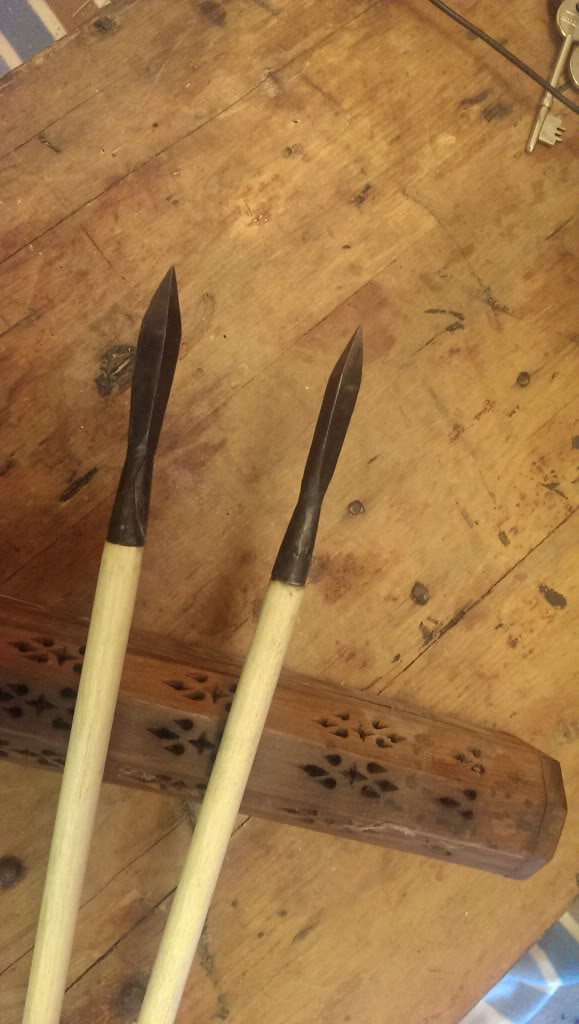
Anyway, congrats on a beautiful military arrow.
By the way - there isn't a whole lot of evidence for 1/4lb arrows being used as they're very heavy compared to normal warbow arrows. The more commonly used arrows for bows over 100lbs are the (EWBS) Standard and Livery, neither of which are heavier than about 1050 grains. The Standard is 800 grains, and the Livery is 980 grains. The Livery is a replication of the arrows found on the Mary Rose, and considering the suspected draw weight of the bows discovered on the same ship, it seems that you don't need much heavier arrows. By the time you reach 1/4lb weight, unless you're using bows of about 150lb they drop very quickly and don't have a whole heap of punch by the end. If you were to make up a set of Standards and Liverys you'd be much better set up for using a bow of 110lbs. A well made Type 10 is perfect for a Standard and shouldn't weigh more than about 150 grains, while a Tudor bodkin (for a Livery) should be around 140 grains.
|
|
   |
 |
|
Brian Nelson
Location: Houghton, MI Joined: 17 Mar 2012
Posts: 43
|
 Posted: Tue 23 Sep, 2014 2:07 pm Post subject: Posted: Tue 23 Sep, 2014 2:07 pm Post subject: |
 |
|
I really appreciate the reply! Do you have contact info for the gentlemen you recommended? Seems like excellent prices. All of your suggestions are great and accurate. For the 1/4 pound weight, my decision to make these was based on a sound perspective. I have a few dozen livery shafts I've made for this project, but I wanted to also record the really heavy arrows hitting so that the end users of the sound library would have a nicely diverse impact collection.
EDIT: nevermind on the contact, I missed the Facebook page. Thanks!
|
|
   |
 |
Josh Wilson

|
 Posted: Tue 23 Sep, 2014 4:11 pm Post subject: Posted: Tue 23 Sep, 2014 4:11 pm Post subject: |
 |
|
Excellent posting Brian! I will be in need of some warbow arrows soon. I ordered some of these shafts from 3Rivers,
http://www.3riversarchery.com/Medieval+War+Bo...eitem.html
and am not very impressed by them. This gives me more ideas on cheaper and better alternatives for filling out the rest of the sheaf.
|
|
  |
 |
|
Brian Nelson
Location: Houghton, MI Joined: 17 Mar 2012
Posts: 43
|
 Posted: Sat 27 Sep, 2014 10:46 am Post subject: Posted: Sat 27 Sep, 2014 10:46 am Post subject: |
 |
|
I would strongly recommend doing them yourself. Those 3Rivers bodkins are very inexpensive. You could make those exact shafts for maybe $8, that's ordering an already-tapered "legit" arrow shaft and buying the bodkin. On another note, these arrows may fly like pigs (max range out of my old 90# bow is about 120 yards) but they sure hit hard. This is a test shot on a 1.7mm thick helm at ten yards.
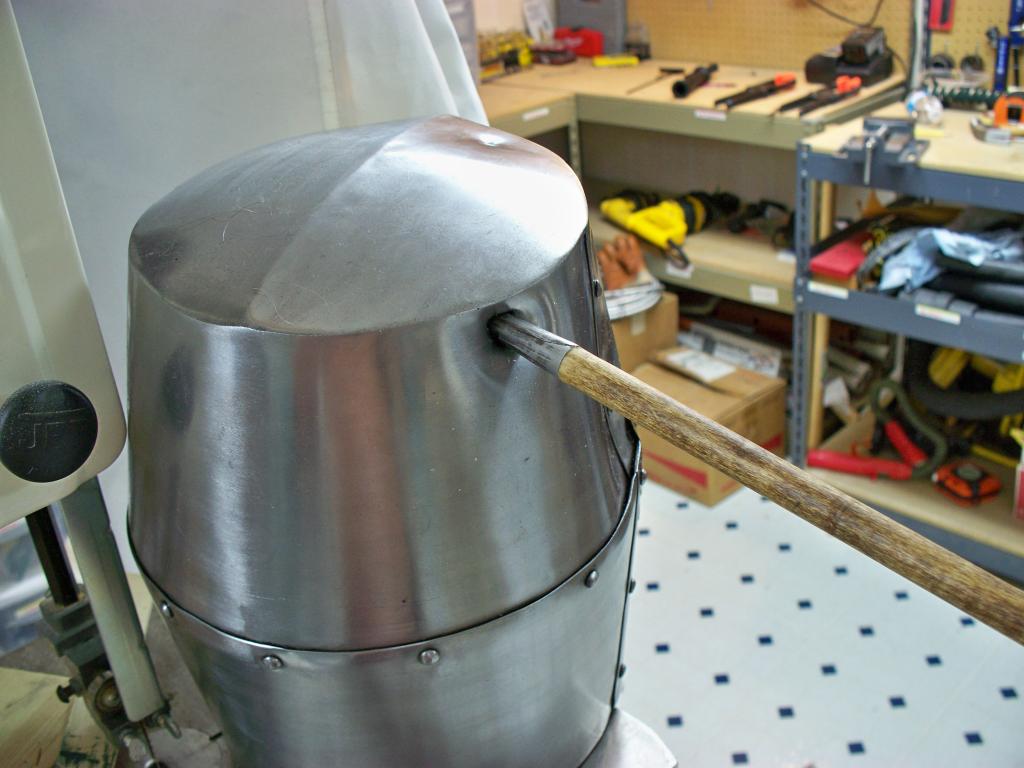

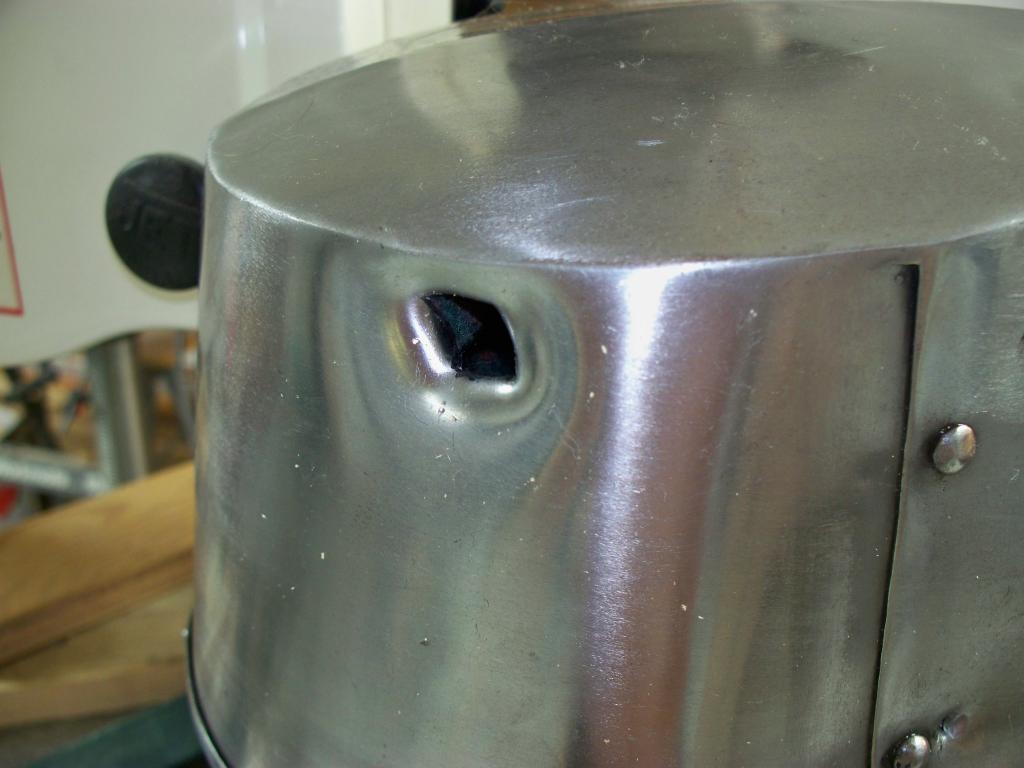
|
|
   |
 |
Daniel Bertrand

Location: Logan, Utah Joined: 13 Apr 2015
Posts: 6
|
 Posted: Mon 13 Apr, 2015 11:09 am Post subject: Posted: Mon 13 Apr, 2015 11:09 am Post subject: |
 |
|
Hi! I am thinking of making some warbow arrows as well. In your first post it says you bought 200 feathers for $110, but what kind of feathers were they? And who did you buy them from? I am trying to search around for a place that sells feathers that cheap but can't find any. Also you said that you got the horn off of ebay? Was that a one-time thing or is the seller still offering?
Thanks
Daniel
|
|
  |
 |
|
Alexis Bataille
Location: montpellier Joined: 31 Aug 2014
Posts: 95
|
 Posted: Mon 13 Apr, 2015 12:21 pm Post subject: Posted: Mon 13 Apr, 2015 12:21 pm Post subject: |
 |
|
|
wow nice hit, at this range and poundage what can be the energy or speed of the arrow ?
|
|
  |
 |
Dan Howard

|
 Posted: Mon 13 Apr, 2015 2:35 pm Post subject: Posted: Mon 13 Apr, 2015 2:35 pm Post subject: |
 |
|
It is great seeing pics of these arrows being assembled but if those heads are supposed to be "plate cutters" then they need to be made of hardened steel. How come none of the extant examples so far analysed are made of hardened steel? Try shooting the same helmet with a head made from soft wrought iron like the originals.
Author: Bronze Age Military Equipment, Pen and Sword Books
|
|
  |
 |
Glennan Carnie

|
 Posted: Tue 14 Apr, 2015 1:40 am Post subject: Posted: Tue 14 Apr, 2015 1:40 am Post subject: |
 |
|
I'm getting a weird feeling of deja vu 
It's far more likely that military arrowheads were wrought iron, but case-hardened to improve their effectiveness.
Good steel is far too expensive to use for vast quantities of munitions arrows; although we do have records of arrows being ordered with 'well-steled' heads at extra cost. Case hardening, on the other hand, is easy to do in industrial quantities, at a fraction of the cost of steel heads.
A case hardened surface is more than adequate for an armour-penetrating arrow. It's not like the arrow has to be retrieved and re-ground multiple times.
The case hardened, high-carbon 'shell' will typically be no more than 1mm in thickness; and quite likely even less, given the propensity of medieval craftsmen to cut corners wherever they though they could get away with it! Burying such an arrowhead in acidic soil for 500+ years is likely to destroy any evidence of high-carbon content, leaving (as you say) simple wrought iron.
|
|
  |
 |
Dan Howard

|
 Posted: Tue 14 Apr, 2015 6:38 am Post subject: Posted: Tue 14 Apr, 2015 6:38 am Post subject: |
 |
|
Its funny how all the case hardening disappeared on those plate cutters but it is still evident on other typologies.
Author: Bronze Age Military Equipment, Pen and Sword Books
|
|
  |
 |
|
Brian Nelson
Location: Houghton, MI Joined: 17 Mar 2012
Posts: 43
|
|
   |
 |
Jasper B.

|
 Posted: Fri 17 Apr, 2015 3:34 am Post subject: Posted: Fri 17 Apr, 2015 3:34 am Post subject: |
 |
|
From what I read you seem to have done your calculations on what you want to create on the basis of arrow weight, based on the shape of a bobtail tapered shaft.
How do you plan to make sure the spine of your shafts/arrows matches your bow?
J.B.
|
|
  |
 |
|
Brian Nelson
Location: Houghton, MI Joined: 17 Mar 2012
Posts: 43
|
 Posted: Fri 17 Apr, 2015 8:05 am Post subject: Posted: Fri 17 Apr, 2015 8:05 am Post subject: |
 |
|
Jasper,
In my personal experience, spine doesn't matter very much at all. Most of these arrows will "spine" around 150+ pounds, I'm using around 100 pounds bow. I have no problems holding an okay group of around six inches at 15 paces.
Also, if you think about this from a historical perspective, you would have archers with bows of wildly varying drawweights and probably wildly different spines for their issued arrows.
|
|
   |
 |
Jasper B.

|
 Posted: Fri 17 Apr, 2015 8:56 am Post subject: Posted: Fri 17 Apr, 2015 8:56 am Post subject: |
 |
|
I don't have detailed knowledge on the longbows, as I shoot a horn bow myself. The Turkish archers had arrows matching their bows (although by rule of thumb, modern calculations show they where pretty close to perfect). Yet it is unclear in how far these matched arrows were used in typical warfare. This doesn't say anything about what they did in England of course. For an English war bow I don't think (but don't know either) they would use arrows matching the draw weight of the bows. Is there anything known about target shooting?
I found that for me, correctly spined arrows make a difference: the arrows seem so much more forgiving to minor mistakes. Maybe I should note that by correctly spined, I do not refer to the number as advertised -which I see as only an indication- but shortened till they fly quite straight without being fletched (landing straight in a target at 10 meters or so). The difference between slightly off and wildly off makes less of a difference, though.
J.B.
|
|
  |
 |
|
Brian Nelson
Location: Houghton, MI Joined: 17 Mar 2012
Posts: 43
|
 Posted: Sun 17 May, 2015 8:56 pm Post subject: Posted: Sun 17 May, 2015 8:56 pm Post subject: |
 |
|
| Jasper B. wrote: | I don't have detailed knowledge on the longbows, as I shoot a horn bow myself. The Turkish archers had arrows matching their bows (although by rule of thumb, modern calculations show they where pretty close to perfect). Yet it is unclear in how far these matched arrows were used in typical warfare. This doesn't say anything about what they did in England of course. For an English war bow I don't think (but don't know either) they would use arrows matching the draw weight of the bows. Is there anything known about target shooting?
I found that for me, correctly spined arrows make a difference: the arrows seem so much more forgiving to minor mistakes. Maybe I should note that by correctly spined, I do not refer to the number as advertised -which I see as only an indication- but shortened till they fly quite straight without being fletched (landing straight in a target at 10 meters or so). The difference between slightly off and wildly off makes less of a difference, though.
J.B. |
It is certainly possible that for target competitions a bowman had "his" own arrows for his bow. But for war, you have to remember that literally millions of arrows were being made in England and shipped to France in bundles. It is an impossibility that archers had arrows that always matched their bows or were even close. However, once you get used to shooting overly spined arrows instinctively it becomes much more consistent to be accurate with any arrow you're given. I have arrows from 120 to 200+ pounds spine that I use with my 100 pound bow, and I don't notice any huge issues. I'm not as accurate as I could be, but i see no reason a skilled bowman could not pout arrows into a mansized target at 100 yards with varrying spines.
|
|
   |
 |
|
|
You cannot post new topics in this forum
You cannot reply to topics in this forum
You cannot edit your posts in this forum
You cannot delete your posts in this forum
You cannot vote in polls in this forum
You cannot attach files in this forum
You can download files in this forum
|
All contents © Copyright 2003-2024 myArmoury.com — All rights reserved
Discussion forums powered by phpBB © The phpBB Group
Switch to the Basic Low-bandwidth Version of the forum
|

